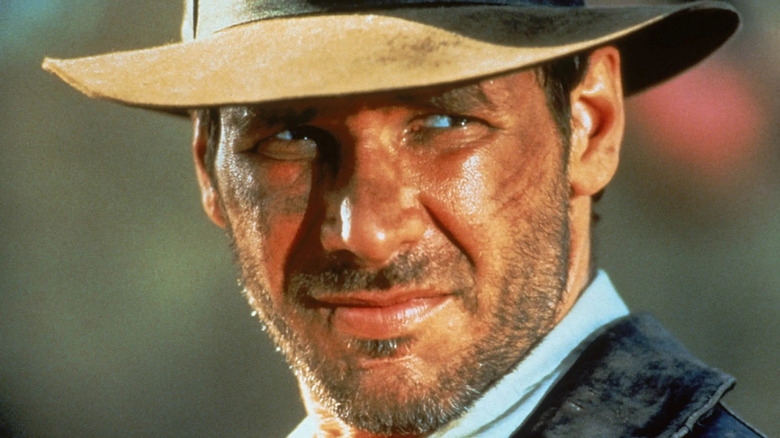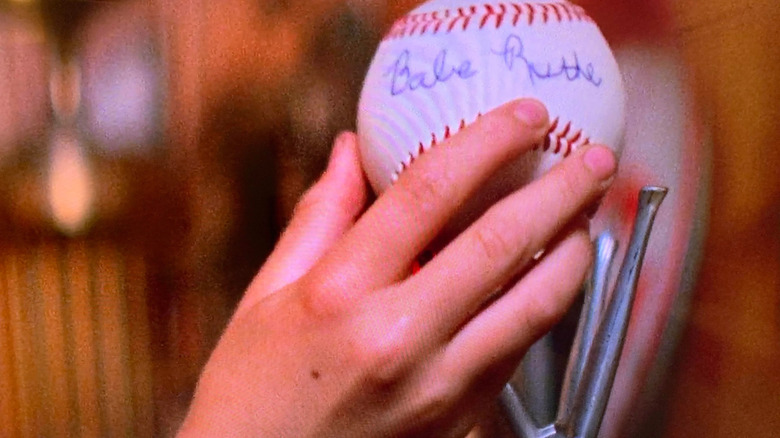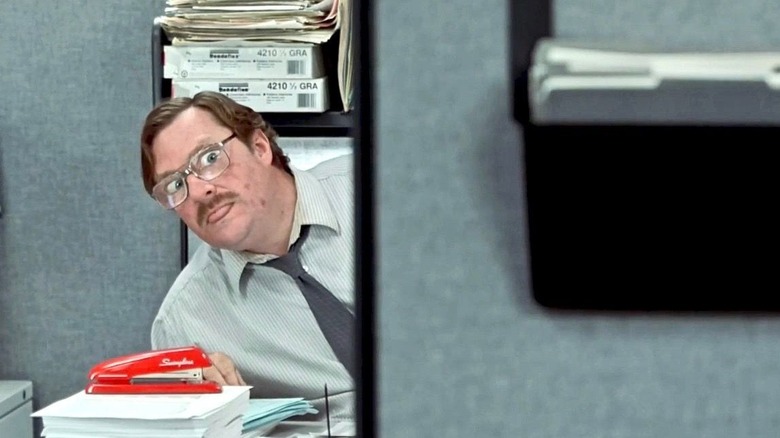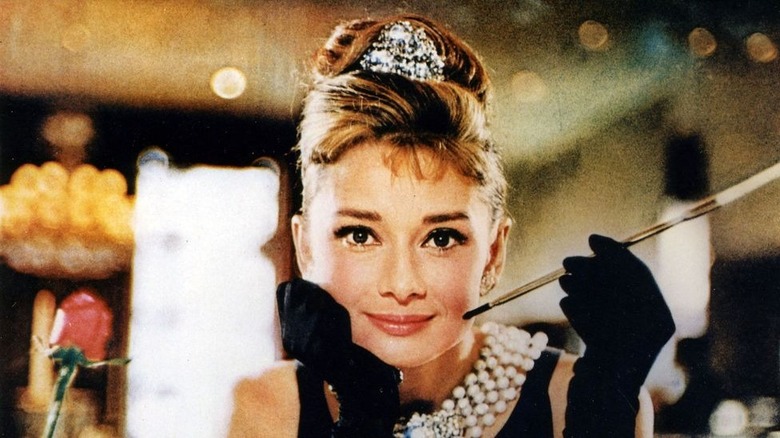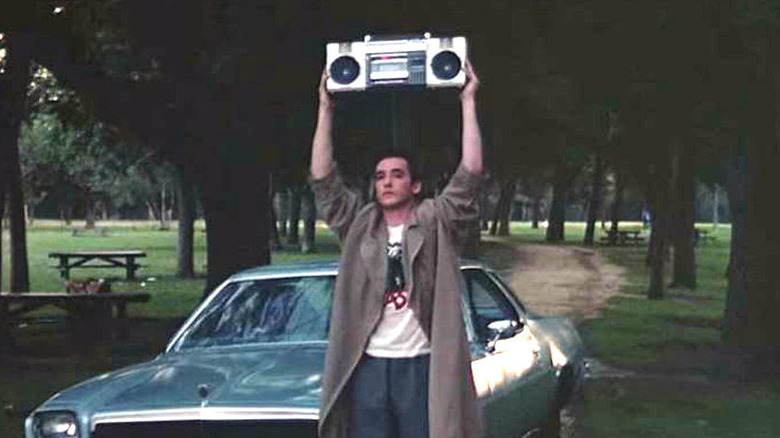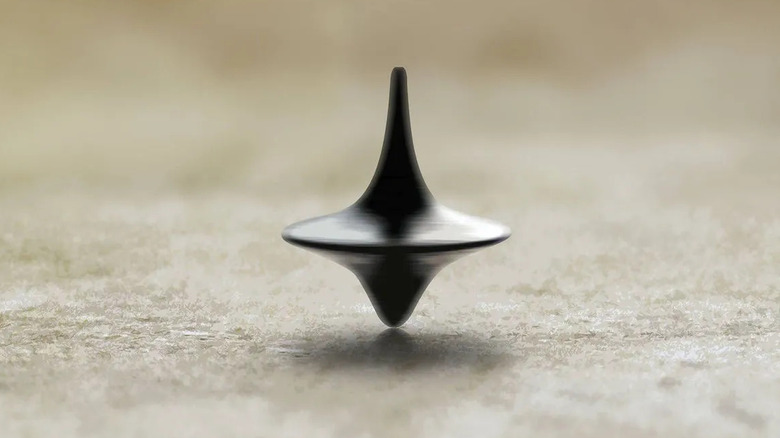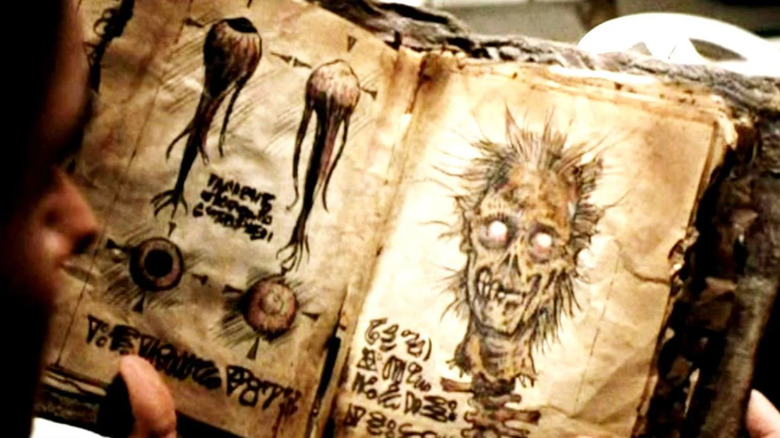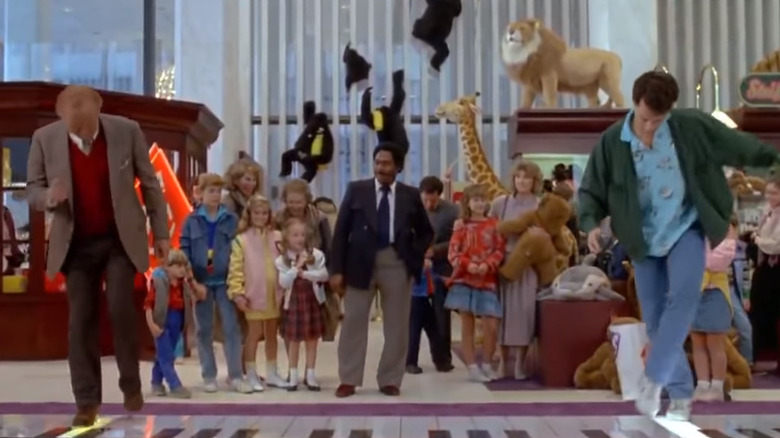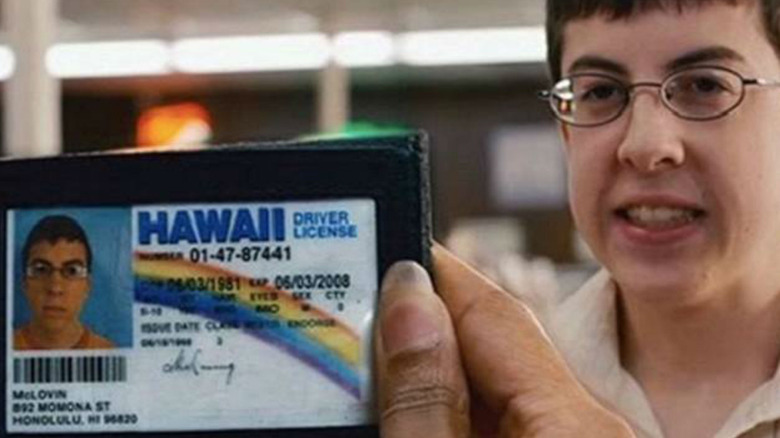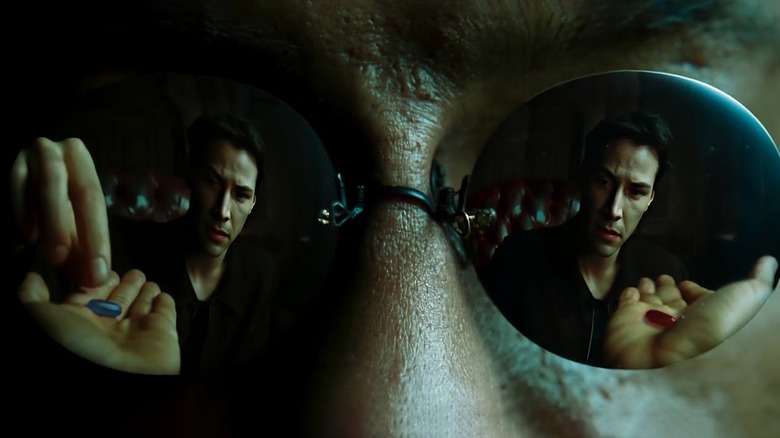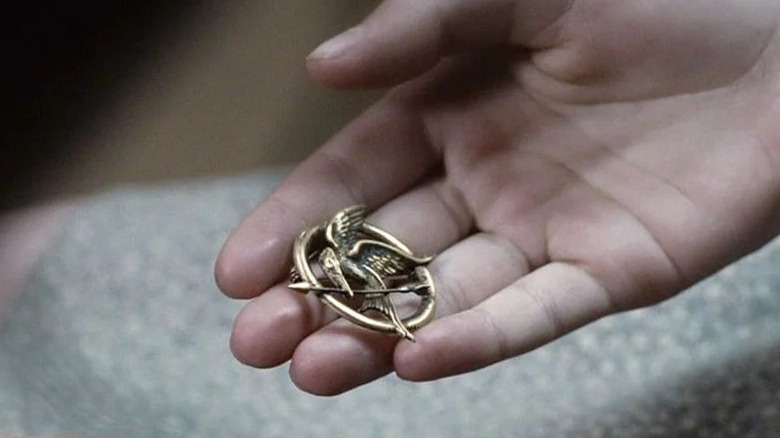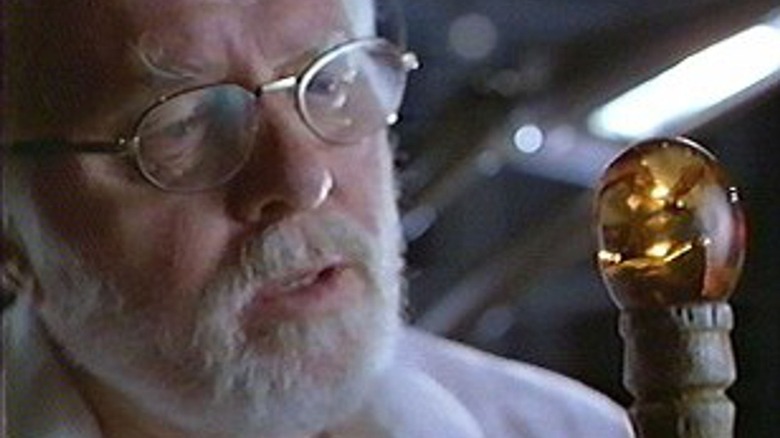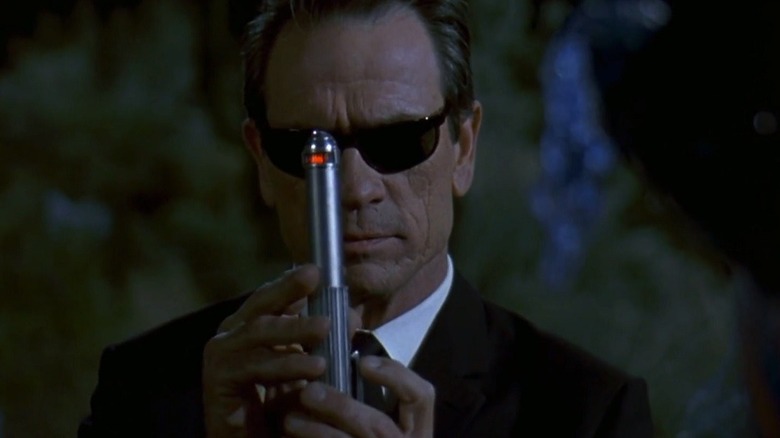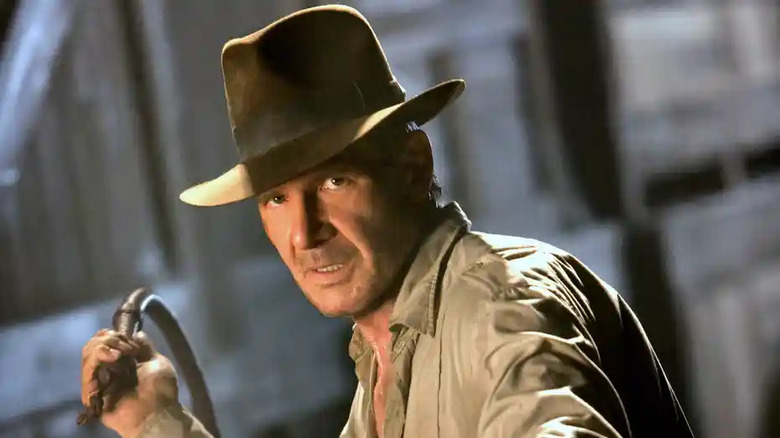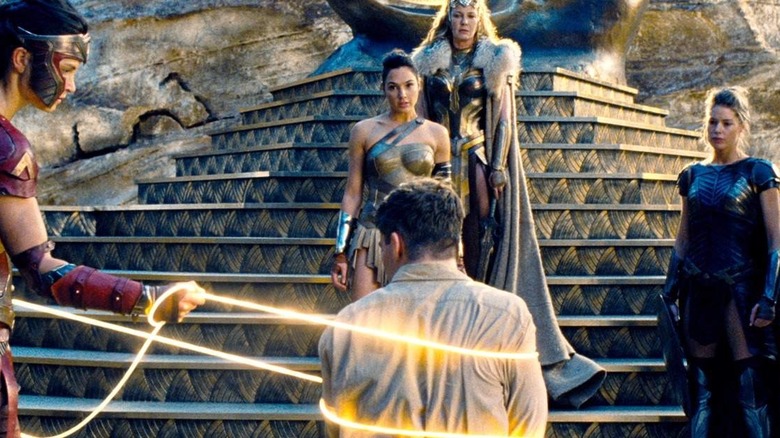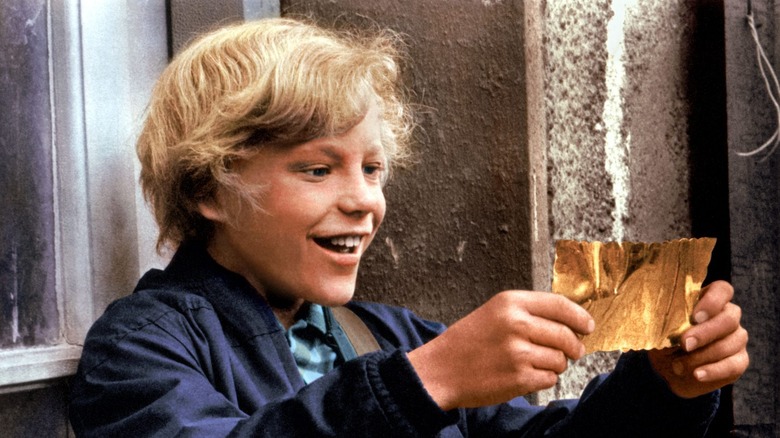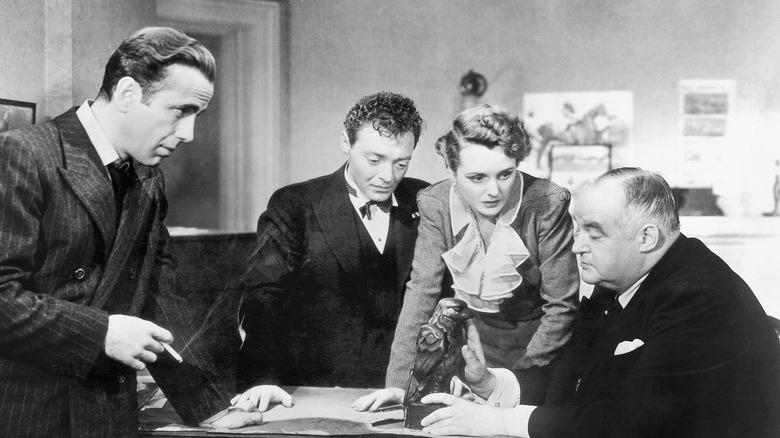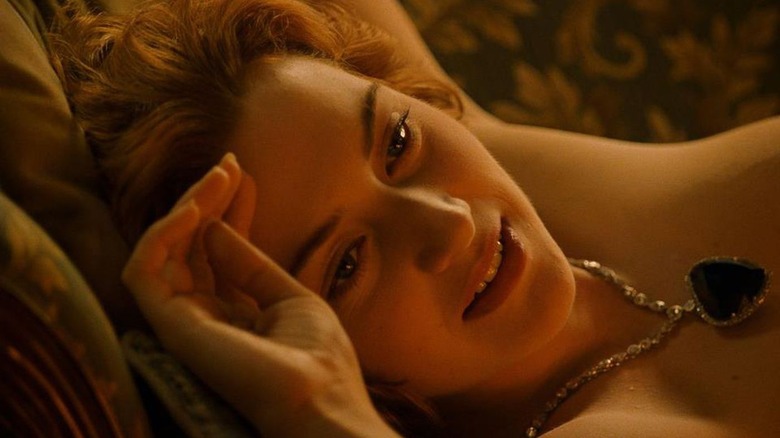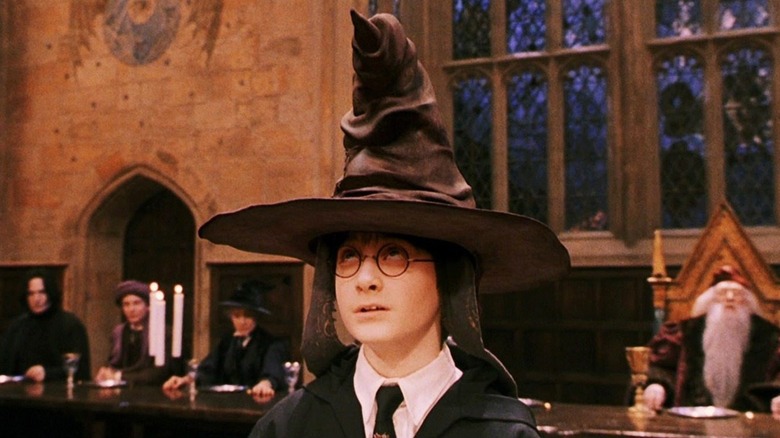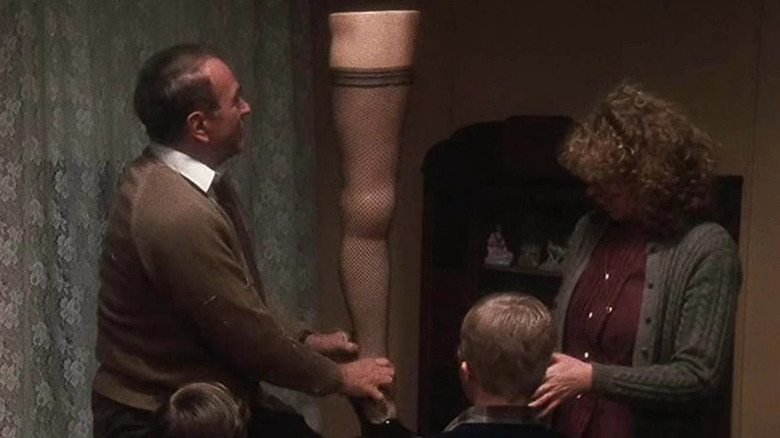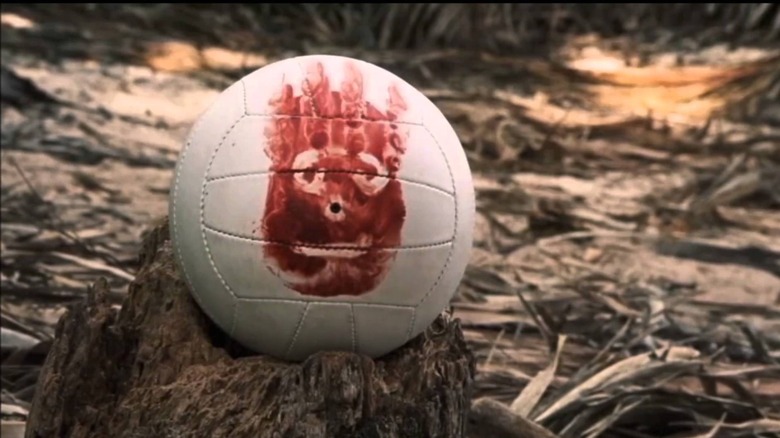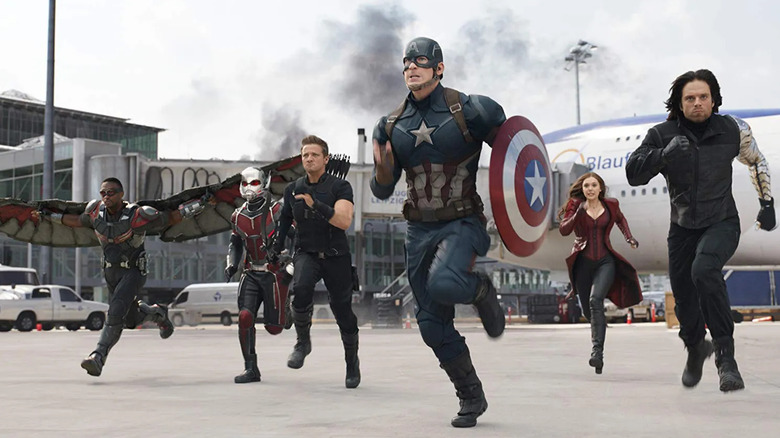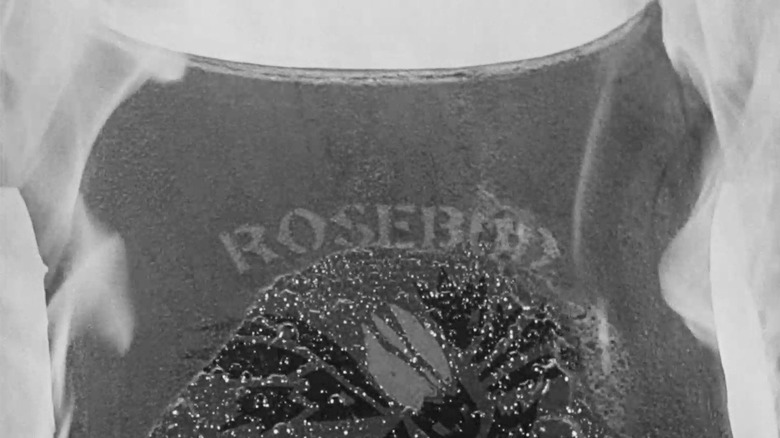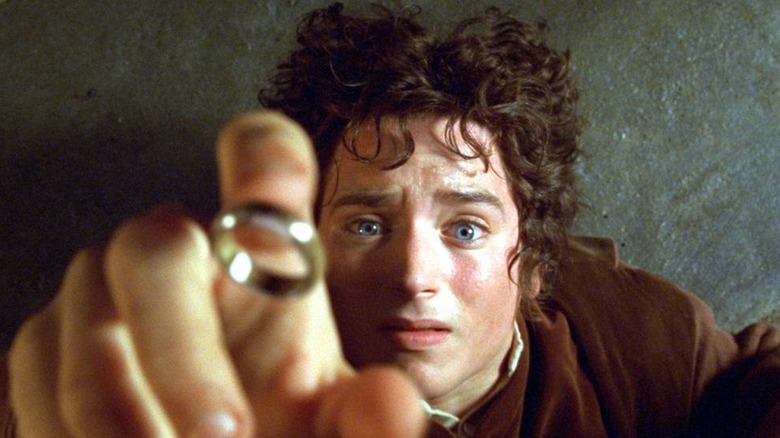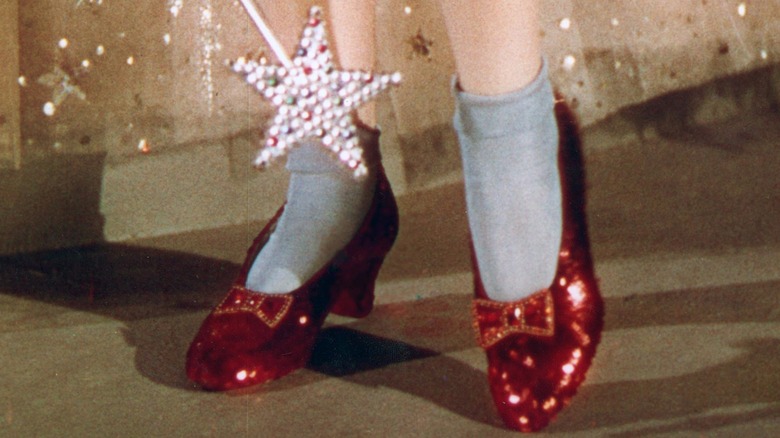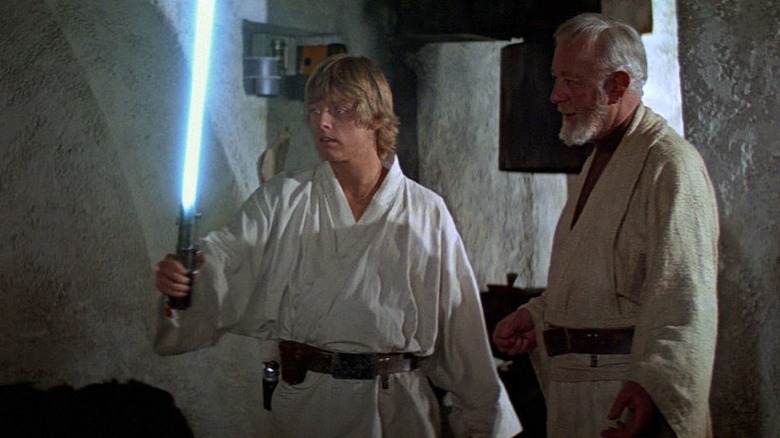The Most Memorable Movie Props Of All Time, Ranked
A good movie prop does just as much work as the writer, director, the actors, or the crew members. Some props — like dinnerware or guns — aren't imbued with much importance by the story and are destined to remain anonymous or be forgotten. But some become just as, if not more, iconic than the characters and films they represent. From valuable trinkets to stylish accessories to one-of-a-kind weapons, the best props give characters something to do and tell us a little something about who they are. And in some cases, the movie couldn't happen without them.
Objects from film history that reach this level of notoriety go on to have a life of their own. Fans may collect replicas of them. Kids may ask for toy versions of them for Christmas. They may become shareable GIFs or in-jokes and references that practically everyone gets. They're frequently parodied in pop culture, perhaps by "The Simpsons" or "Saturday Night Live." Some are so historically and culturally relevant, they're now housed securely in museums. These are the most memorable movie props of all time, ranked.
25. Babe Ruth signed baseball -- The Sandlot
A good movie prop doesn't just give a character something to do, it factors into the plot. The Babe Ruth signed baseball from 1993's "The Sandlot" isn't unique (people have them in their real-world collections), but without it, the main storyline in this cult classic coming-of-age movie can't happen.
In "The Sandlot," shy fifth grader Scott Smalls moves to Los Angeles and tries to fit in with the kids who play baseball in his neighborhood, despite the fact that he isn't very good because his stepdad — who loves baseball — never practices with him. The team's de facto leader, Benny, accepts him anyway, and Smalls has the best summer of his life ... that is, until he borrows a baseball from his dad's trophy room for a simple pick-up game. When he hits his first-ever home run, the ball sails into the yard of "the beast," a supposedly vicious dog who's rumored to eat children.
This unfortunate development spells embarrassment and doom for Smalls. He's mortified when his new friends find out that he didn't know who the Great Bambino was, and he's even more distraught at the idea of having to tell his stepdad about what he's done. The whole quotable final act of "The Sandlot" revolves around the ball and will be forever in the hearts of baseball and movie fans alike.
24. The red stapler -- Office Space
Mike Judge's 1999 workplace comedy predates its popular cousin — the TV series "The Office" — by about five years. That show started off with a bit about a stapler too, but the red stapler in "Office Space" is more symbolic, no Jell-O mold needed.
"Office Space" is mostly about Peter Gibbons' (Ron Livingston) misery as he works a pointless, mid-level job at Initech, but some of the best jokes have to do with someone lower on the corporate ladder: Milton Waddams. Always reliable character actor Stephen Root brings Milton to life with relatable but very specific anxiety and thick glasses. However, he's defined most by his love of his red Swingline stapler. The bosses have already repeatedly made him change cubicles and they've halted his paychecks without telling him, so it adds insult to injury when they come for his prized piece of equipment.
The red stapler about which Milton so hilariously mumbles is representative of the dignity, individuality, and ownership of their lives that workers try to hold on to as they toil away for the man.
23. The cigarette holder -- Breakfast at Tiffany's
At this point, 1961's "Breakfast at Tiffany's" is as much of a vintage movie poster as it is an actual movie, but in both, Holly Golightly's cigarette holder is front and center. Though it wouldn't be fashionable to equate smoking with elegance today, at the time of its release, that long, skinny accessory was an important piece of character development.
Holly (Audrey Hepburn in her most iconic role) appears to be an effortlessly stylish city girl. From mobsters to writers to politicians, every man who meets her wants her company. But fairly early on in "Breakfast at Tiffany's," we learn that Holly's real name is Lula Mae Barnes, and that after being forced to marry at 14, she escaped her dull country life in Texas for the bustle and thrill of New York. Her hair, makeup, and outfits (including that ever-present prop) visually illustrate her transformation. No Audrey Hepburn as Holly Golightly Halloween costume would be complete without it.
22. The boombox -- Say Anything...
In the best cases, a movie prop can make for a movie moment so memorable, fans recreate the scene for decades to come. Surely there are people who've mimicked holding a boombox over their head as a show of affection without ever having seen Cameron Crowe's 1989 debut, "Say Anything..." The act itself has become shorthand in popular culture and will forever be associated with the song that's blaring from those speakers, Peter Gabriel's "In Your Eyes."
Slacker Lloyd Dobler (John Cusack) decides he wants to ask out overachiever Diane Court (Ione Skye) not long before graduation. These opposites do attract, and Lloyd and Diane hit it off, but their divergent futures and her disapproving father complicate their budding romance. When Diane ends things at her dad's urging before leaving for a highly sought after fellowship in Great Britain, Lloyd tries to win her back by playing their song. 1989 was the year of the boombox in cinema; another one shows up in Spike Lee's "Do the Right Thing."
21. The spinning totem - Inception
It's a common action movie trope for the characters to be in pursuit of an object, but in Christopher Nolan's 2010 sci-fi hit "Inception," they're after ideas. This little spinning top is instead a physical manifestation of the film's purposely ambiguous ending.
Leonardo DiCaprio plays Cobb, an extremely specialized agent who can extract important information from the memories and dreams of clients (or marks). But one of those clients — a man named Saito — wants him to do the opposite and place a manufactured notion into the subconscious of a competitor. In exchange, he'll expunge Cobb's criminal record so that he can go home to his children. It's revealed that Cobb was implicated in his wife's death after she could no longer tell the real world from the dream world.
The inceptors design and implement a three-layer-deep dream for their target, which is dangerous and could land them all in permanent limbo. Though Cobb fulfills his mission and is reunited with his kids, he can only be sure he's actually re-entered reality if his personal totem eventually topples — which the movie leaves unresolved.
20. The Necronomicon -- The Evil Dead
Proverbial books of the dead, usually based on the historical Egyptian Book of the Dead, pop up in genre fiction and film all the time. A close runner-up for the 20th spot on this list is the decidedly less threatening Handbook for the Recently Deceased from "Beetlejuice," but the Necronomicon in Sam Raimi's "The Evil Dead" spawned a whole franchise and plays a bigger role in the story.
In "The Evil Dead," five friends take a trip to a remote cabin in the woods and discover a tape recorder and a creepy old book. When they play the tape which recites the book's incantations, they unwittingly unleash its evil. One by one, Ash's traveling companions become possessed by the book's demonic force and are turned into deadites, whom he must dismember if he wants to remain alive. Deadites can't really be killed, but the bodies in which they've taken up residence can be destroyed, which sends them back to the underworld for a while. Similarly, Ash tries to destroy the Necronomicon to stop the threat of deadites once and for all, but it's as persistent as the dark souls to which it's bound, and it lives to see two sequels plus a TV show and a reboot.
19. The FAO Schwartz piano -- Big
1988's "Big" is, at once, one of the most charmingly nostalgic and problematic movies of the '80s. A fortune-telling carnival machine called Zoltar turns 12-year-old Josh into an adult man after he makes a wish to be grown up. Josh abandons his parents to worry about his whereabouts and, implausibly, manages to land a high-earning job at a toy company, a loft apartment, and a beautiful girlfriend. The Zoltar machine is the prop that provides the inciting incident, but the floor piano on sale at FAO Schwartz is the prop for which "Big" is most remembered.
In the scene in question, Josh impresses the owner of his company by enthusiastically tapping out a tune on the walking piano in front of a gathered crowd. The routine is a demonstration of his childlike ability to understand and appreciate toys, and the owner promotes Josh to the executive roundtable in hopes that this perspective will pay off. Walking pianos continue to be sold today, and when people spot one on display, they inevitably shout, "Big," and get to dancing.
18. McLovin's driver's license -- Superbad
A good measure of whether a prop has become memorable is whether it's sold as memorabilia. 2007's "Superbad" became a cultural phenomenon that made nearly nine times its budget at the box office, but this little piece of plastic is what has endured, and copies of it are still available for sale at many major retailers.
Nerdy high school seniors Seth (Jonah Hill) and Evan (Michael Cera) experience a stroke of good luck when Seth's popular lab partner, Jules (Emma Stone), invites him to her party. Their friend Fogell (Christopher Mintz-Plasse) claims he can get a fake ID, so the trio offers to provide Jules with alcohol in an attempt to up their cool factor. It turns out that Fogell's phony license contains only one name: McLovin. It also states that he's 25 and an organ donor.
The McLovin ID became such a cultural flashpoint that memes about it persist more than a decade later and some people (including the cast and crew) even commemorate McLovin Day on June 3rd.
17. The red and blue pills -- The Matrix
From its mind-bending story to its cutting-edge visuals, the Wachowskis' 1999 sci-fi masterpiece "The Matrix" is among the most influential movies of all time. Two of its props — a blue pill and a red pill — have become not only visual symbols but verbal shorthand, especially for extremely online and conspiratorial types. In the film, rebel leader Morpheus offers chosen one Neo two pills. The red one will awaken him to the truth of his reality, which is that machine overlords are keeping him prisoner in a simulation. The blue one will grant him continued obliviousness upon his return to that simulation. Neo chooses the red pill, escapes the trance, and joins the rebels.
In the years since the film's release, some fans have taken to using the term "red pilled" to mean learning what they believe to be harsh but necessary truths about the world. However, the Wachowskis have been vocal about their specific inspiration, which has little to do with conspiracy theories and more to do with their perspectives on identity.
16. The mockingjay pin -- The Hunger Games
Suzanne Collins' dystopian trio of young adult novels was such a phenomenon that it only took four years for "The Hunger Games" to become a major motion picture. The story of District 12's Katniss Everdeen, who volunteers to fight to the death in her sister's place, is philosophically pliable. Is it about wealth inequality and capitalism run amok? Yes. Is it about government overreach? Also yes. "The Hunger Games" and Katniss's vague politics are summed up by the mockingjay pin she wears. It also graces the covers of most editions of the trilogy.
The movie's version of events regarding the pin is a little different than the book's. In print, before our favorite sad sack teenage archer is about to board the train to her date with ritualized violence, her friend Madge gifts her the pin (which belonged to her aunt, who also competed in the games) as a token. In the film, someone at the black market hands her the pin, which goes on to become the symbol of the resistance. The mockingjay motif is significant. The new species is the result of unintentional breeding between the Capitol's genetically-engineered jabberjays and wild mockingbirds. They can be used by rebels to share messages and their very existence is proof of the Capitol's shortsightedness.
15. The mosquito in amber -- Jurassic Park
Steven Spielberg's 1993 mega-blockbuster "Jurassic Park" is full of images that live on in the viewer's brain. A glass of water has never been so terrifying. The can of shaving cream that contains the stolen dinosaur DNA is infamous enough to have almost made this list, but it's the mosquito trapped in amber that better represents the "Jurassic Park" franchise, and explains how humans were able to bring the great lizards back in the first place.
In the first "Jurassic Park," entrepreneur John Hammond (Richard Attenborough) invites three experts — Dr. Alan Grant (Sam Neill), Dr. Ellie Sattler (Laura Dern), and Dr. Ian Malcolm (Jeff Goldblum) — to assess the safety and viability of his already constructed dinosaur theme park. When those experts are shocked at the presence of real living dinosaurs, Hammond explains that his scientists were able to extract DNA from blood that remained in petrified mosquitos, which they spliced with that of modern frogs. The mosquito in amber is lovely to look at but also foreboding, and the reasoning behind it contains just enough jargon to make "Jurassic Park" seem less like science fiction.
14. The neuralyzer -- Men in Black
This 1997 sci-fi action comedy was one of Will Smith's many July 4th weekend hits (and the second in a row to deal with alien invasions). "Independence Day" came first but was more of an ensemble piece. Smith was co-lead in "Men in Black" as Agent J to Tommy Lee Jones' Agent K, and it's likely the film, role, and original song for which he'll best be remembered. Speaking of memory, Smith surely wishes he had one of the movie's handy dandy neuralyzers right about now. The devices look just the right amount of futuristic kitschy, but more importantly, they make the plot conceit work.
As it's impossible for the MIB to do their work (containing alien threats) without any witnesses, agents turn to the neuralyzer to erase the short-term memory of anyone who observes alien activity here on Earth. The film is full of cool gadgets, and there's a great gag about Agent J's displeasure at being assigned the absurdly tiny "noisy cricket" gun. But guns — even highly stylized ones — have been a fixture in Hollywood since the beginning. The neuralyzer is an innovation and contribution by "Men in Black" to pop culture.
13. Indy's hat and whip -- the Indiana Jones franchise
Indiana Jones hunts treasure, so one might expect something like the fertility idol from "Raiders of the Lost Ark" or the Holy Grail to show up on this list. Even the enormous, perfectly round, rolling boulder is so familiar, it's been parodied many times over. But the two constants in Indy's life are his hat and his bullwhip, which — as we learn in "Indiana Jones and the Last Crusade" — he acquired as a result of the same daring incident from his childhood Boy Scout trip.
The hat and whip are inextricable enough from Indiana Jones's whole persona that a person could don only those two accessories as a costume and still successfully pass for the character. However, they aren't just accessories. Indy often relies on the whip to get himself out of a bind, whether he uses it as a weapon or a mechanism from which to climb or swing. It's always ready at his hip, just as surely as his fedora is on his head. That brown hat means enough to him that he is willing to risk his life for it; he notoriously goes back for it after escaping a booby-trapped, spiked room with a rapidly closing door.
12. The Lasso of Truth -- Wonder Woman
From batarangs to motherboxes, the DC Extended Universe has its fair share of sellable props, just like the other, even more omnipresent cinematic universe that originates from comics (note that vehicles like the Batmobile or the Invisible Jet were not considered for this list). Wonder Woman's Lasso of Truth might be the least likely item to be sold at a store, but out of all the Justice League's gear, it does the most work when it comes to plot and character development.
The golden glowing rope can, like Indy's whip, disarm enemies in combat and serve as a piece of life-saving equipment. What it's really known for, however, is its ability to compel those who find themselves tied up in it to tell the truth, and we all know that nothing is more disarming than total honesty. It's consistent with Wonder Woman's whole ethic and aesthetic as a superhero, and can be deployed for action, drama, and comedy.
11. The golden ticket -- Willy Wonka and the Chocolate Factory
1971's "Willy Wonka and the Chocolate Factory" may have tweaked the title to Roald Dahl's 1964 kids' book, "Charlie and the Chocolate Factory," but it still serves up the author's signature concoction of dark and sweet (even if Dahl himself didn't exactly appreciate the final product). Charlie lives in dire poverty with his mother and grandparents and can't afford the candies he passes by on his paper route. But when factory owner Willy Wonka (Gene Wilder) announces that he's hidden five golden tickets in chocolate wrappers across the globe, and that those who find them will get to tour his long-closed-to-the-public facilities, Charlie splurges to buy one Wonka bar.
Though realistically the math isn't in his favor, Charlie ends up with one of the tickets. The tour of the factory is both an excuse to have some fantastical musical fun and a children's morality tale about greed and temptation. "Willy Wonka and the Chocolate Factory" wasn't a runaway success upon its release, but became a beloved classic once it started airing on TV in the 1970s. Its golden ticket promotion has become an idiom in the lexicon, and copies are still printed for themed parties the world over.
10. The Maltese Falcon -- The Maltese Falcon
Few props in Hollywood history are so central to the film in which they appear that they become its title. 1941's "The Maltese Falcon," starring Humphrey Bogart, is actually a remake of a movie of the same name, based on a book of the same name, but it's the quintessential version. The Maltese Falcon itself is one of the earliest examples of a MacGuffin.
Sam Spade is a private investigator whose partner winds up dead when they agree to help a woman find her missing sister. That heinous crime is Spade's first step into a glamourous but seedy underworld where nobody can be trusted and everyone's after the titular sculpture, a gold and bejeweled bird that was gifted to a royal in the 16th century. The statue has a basis in history and starts out as a precious relic representing loyalty, but over the course of the film, it becomes a symbol of corruption and paranoia.
In a case of life imitating art, several versions of the Maltese Falcon were created for the film's production. The authenticity of those props (some of which have sold for hundreds of thousands to millions of dollars) is a gripping mystery in and of itself.
9. The Heart of the Ocean -- Titanic
James Cameron's "Titanic" was the first film ever to reach the billion dollar mark, but it couldn't have done so if it was only about a boat that everyone on the planet knows is about to sink. The filmmakers cleverly added a framing device and a love story to this epic about the ill-fated ship, which helped fuel all those ticket sales and propelled it to an Oscar for Best Picture.
Rose (Kate Winslet) comes from privilege but she needs to marry well to keep her family in society's upper ranks. Cal (Billy Zane), whom Rose does not love, make his intentions (but really, his obscene wealth) known when he gifts her with the Heart of the Ocean, a historically significant, enormous blue diamond. "Titanic" begins and ends with a modern day researcher's hunt for the lost gemstone. The film is mostly an extended flashback sequence that reveals what became of it.
The Heart of the Ocean (which was based on the Hope Diamond as well as a real sapphire that was allegedly aboard the ship) created an entire cottage industry of licensed and unlicensed replicas. Though Bill Paxton never found it, copies of the necklaces can still be procured today for anywhere from $2 to several thousand dollars.
8. The Sorting Hat -- Harry Potter and the Sorcerer's Stone
Page for page and frame for frame, no franchise can boast quite as much invented stuff as "Harry Potter." In fact, the series culminates with a quest to track down seven magical pieces of memorabilia. From commonplace items like envelopes and Harry's glasses to extraordinary objects like golden snitches and the Mirror of Erised, the Wizarding World is full of props so cool, a flagship store devoted to selling wares and replicas recently opened in New York City. One might expect Harry's wand to appear on this list, but only true Potterheads can separate Harry's 11-inch, holly-and-phoenix-feather model from, say, the Elder Wand. And magic wands aren't new to "Harry Potter."
The Sorting Hat, however, is original to the franchise and is both a prop and a character unto itself. If "Harry Potter" is known for anything, it's the four color-coded wizarding houses, which makes the Sorting Hat one of the most critical elements to the story, especially when it goes above and beyond to help Harry out of sticky situations in subsequent volumes. The hat's folded face and voice (provided by actor Leslie Phillips) are instantly recognizable even to those who aren't familiar with "Harry Potter."
7. The leg lamp -- A Christmas Story
Every December, "A Christmas Story" airs round-the-clock on cable TV and leg lamps go up in windows of the 1983 holiday classic's many devoted fans. Ralphie Parker and his family might not be wizards or superheroes, and "A Christmas Story" might not be revered in quite the same way that "The Maltese Falcon" or "Titanic" are. But the film is still important enough to have been preserved by the National Film Registry, and the leg lamp is one of the most memorable, hilarious, and Christmas spirit-inducing props in the annals of Hollywood.
"A Christmas Story" is mostly about how much Ralphie wants a Red Ryder air rifle (and if BB guns didn't exist outside of the movie, Ralphie's present could have been a strong candidate for this list), but the story unfolds through a series of semi-related vignettes. In one, Ralphie's dad receives a "major award" that comes in a large crate labeled "FRAGILE," which he mispronounces. To his mother's horror, his father displays the showy lamp for all the neighbors to see. None of the leg lamps created for the movie survived production, but you can purchase your own major award and see where the film took place at The Christmas Story House and Museum in Cleveland, Ohio.
6. Wilson -- Cast Away
When news broke about Tom Hanks' 2000 survival film, "Cast Away," all everyone knew was that the actor had lost a shocking amount of weight and that he spent most of the film's runtime performing what amounted to a one-man show on an island. But anyone who's seen "Cast Away" knows that Hanks' Chuck Noland wasn't alone. He had Wilson, the volleyball with a bloody handprint for a face who stole the heart of one desperately marooned former FedEx employee and the world.
Chuck's relationship with the ball mostly plays for comedy in the early scenes, but when it floats away near the film's conclusion, the audience is genuinely devastated, as if an actual death has occurred. Wilson's presence keeps the middle part of "Cast Away" inflated with life and purpose. Between its simple-seeming design and Hanks' incredible performance, this is probably the most that a true prop has ever been developed as a character. The sports company after which it's named continues to sell "Cast Away" Wilson volleyballs today.
5. Captain America's shield -- the Marvel Cinematic Universe
A 20-plus (and counting) film franchise full of more superheroes than one can fit on a T-shirt is going to come preloaded with a lot of props. One need only visit any toy aisle to see how iconic the various weapons and implements of the Marvel Cinematic Universe have become. But which is the most memorable? A case can be made for Mjolnir or the Infinity Gauntlet. Thor's war hammer is enchanted, and the MCU makes a running plotline-slash-joke out of who is worthy enough to wield it. The stone-encrusted golden glove provides the climax to three phases of $100 million dollar movies. But — though it isn't as magical as Thor's hammer or as powerful as the Gauntlet — Captain America's shield is easily Marvel Studios' most recognizable symbol.
Cap's shield — which was created by Tony Stark's father, Howard, and is made of vibranium — appears in seven MCU movies (Cap uses a different variety in "Avengers: Infinity War"). It's basically the subject of its own Disney+ show in "The Falcon and the Winter Soldier," and it's such a powerful image in its own right, the Statue of Liberty is holding one in "Spider-Man: No Way Home." The shield can be used offensively and defensively, and is almost but not totally indestructible. Though its patriotic allusions aren't exactly subtle, it's worth noting that Cap has gone rogue (as did his replacement, John Walker), which makes the shield an inspiring and complicated encapsulation of heroism.
4. Rosebud -- Citizen Kane
Rosebud is many things. It's a metaphor for innocence and a parent's love (and ultimately their loss). It's become a trivia-like test of whether or not a person has seen Orson Welles' masterpiece, "Citizen Kane." And spoiler alert: it's a sled. Rosebud is only mentioned at the beginning and ending of the film, but this thematically-charged prop is key to unlocking what "Citizen Kane" is really about.
The film chronicles the down and up and down again life of Charles Foster Kane (Welles), a fictional character based on early 20th century media magnates like Joseph Pulitzer and William Randolph Hearst. Kane starts out as the child of poor parents who, ostensibly in his best interests, send him to a boarding school and set him up with a trust. He quickly ascends to mine operator, then newspaper owner, and eventually runs for political office himself, but he is (as used to be so often the case) brought down by a scandal. As Kane becomes richer and more powerful, he also becomes more manipulative and duplicitous, not to mention hubristic. "Citizen Kane" opines on the ways we measure a man's (in particular, an American businessman's) greatness. In the end, a slowly burning Rosebud obliquely challenges our preconceived notions.
3. The One Ring -- The Lord of the Rings Trilogy
Dreamed up by J.R.R. Tolkien and made visible by Peter Jackson, the One Ring (also known as the Ring to Rule Them All or Isildur's Bane) is probably the cleanest metaphor ever created. In "The Lord of the Rings," the wizard Gandalf tasks humble hobbit Frodo with transporting the Ring from the Shire, where his uncle has been hoarding it for decades, to Mount Doom, where Gandalf insists it must be destroyed. That sets up an adventure in excess of nine hours in which Frodo and his traveling party of elves, dwarves, humans, and more must evade and do battle with orcs, giant spiders, and various other demonic supernatural beings all sent by a supremely powerful and evil undead sorcerer.
The One Ring makes a simple but undeniable statement about the corrupting influence of power. It's a testament to Frodo's altruism that he's chosen to bear its burden because he won't succumb to its temptations. That Tolkien made his entire saga about destroying and not finding the source of ultimate power provides a clear-as-day window into his thoughts on the subject. On a less serious note, Andy Serkis's oft-imitated line reading of the word "precious" has certainly elevated the already iconic Ring's status in film reference and meme culture.
2. The ruby slippers -- The Wizard of Oz
Countless visitors to the Smithsonian's National Museum of American History in Washington D.C. have already seen Dorothy's ruby slippers on display. That's how noteworthy these red sequined shoes are: they're in a museum devoted to American history and not just film history, though another pair now resides in the Academy Museum of Motion Picture Arts and Sciences in Los Angeles. As was the case with other props on this list, several pairs were made throughout the production of the 1939 Technicolor classic, "The Wizard of Oz."
Dorothy comes to wear the slippers when her house accidentally crash-lands on the Wicked Witch of the East, who's in possession of them at the time of her death. Glinda the Good Witch makes them magically appear on Dorothy's feet so that the Wicked Witch of the West can't get to them first. Glinda assures Dorothy that they're "very powerful," though their primary power seems to be transporting Dorothy back home after she misses her hot air balloon back to Kansas. Whether the viewer chooses to believe that Oz was an actual adventure or a concussion-induced dream, the slippers are a shiny, happy reminder to Dorothy that the folks at home love her.
1. The Skywalker lightsaber -- Star Wars
How many kids (and let's be honest, fully grown adults) have picked up a stick and pretended to be Luke Skywalker? The answer is a lot, and for more than 40 years and counting. George Lucas's "elegant weapon for a more civilized age" is the single most ubiquitous prop in cinema history. Everyone — even people who've never seen "Star Wars" — knows what it is, what it does, and how it sounds. There's often a waitlist to make one — at a cost of more than $200 — at Disneyland and Walt Disney World. You can buy lightsaber-themed chopsticks, chocolate molds, night lights, etc. The lightsaber might be the most commonplace, recognizable object that isn't actually real.
Lightsabers provide awesome visual effects and define the characters who wield them. Darth Vader's red one and Darth Maul's double-bladed one are both legendary. But the lightsaber is, undoubtedly, the blue one first crafted and used by Anakin Skywalker. Eventually, it's passed down to his son Luke by his former master Obi-Wan Kenobi. The sequel trilogy never quite explains how Maz Kanata ends up with it, but Rey takes possession and telekinetically passes it to Kylo Ren in battle. Let "Star Wars" be a lesson to anyone hoping to create their own epic franchise someday: a great prop goes a long way.
